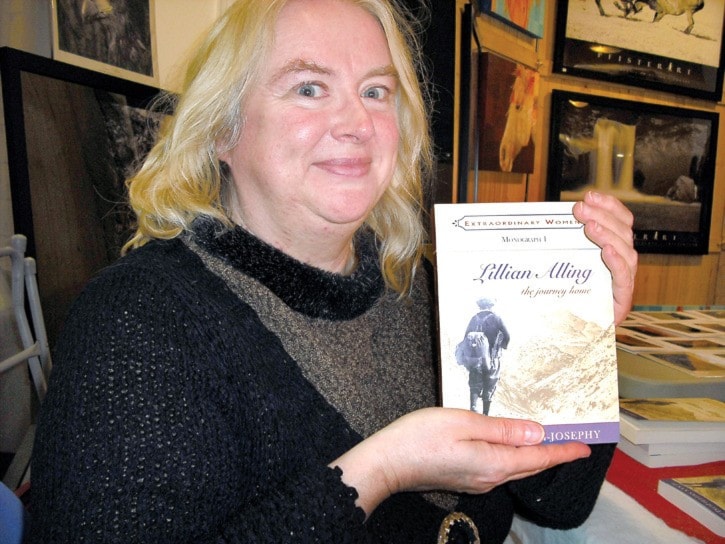It took Quesnel author Susan Smith-Josephy four years to research and write her book Lillian Alling: The Journey Home. This was a full year longer than the events described in the book of Polish immigrant Lillian Alling walking across North America from New York to Alaska in the 1920s to return home.
Alling crossed the Canadian border at Niagara Falls on Christmas Eve, 1926. What made her epic trek peculiar is that her homeland was in Eastern Europe, yet she set off in the opposite direction, walking westward and north. She eventually reached the Bering Sea in August 1929.
As Smith-Josephy points out, the beginning and ending of Alling’s life remain a mystery. She landed in New York City from Europe at an undisclosed date, and records documenting the end of her journey are vague. But her trek across the continent, once she reached British Columbia, Yukon and Alaska, there is a pretty good paper trail in newspaper articles, magazines, books and in the lore of the country.
“I love to do research,” says Smith-Josephy who first got interested in Alling’s story when she came across an article about her in 2007. “So I started looking things up for clarity.”
Smith-Josephy says the more she researched the story, the more she found it engaging and the character of Alling magnetic.
“Lillian Alling was intriguing, stubborn and single-minded, and I felt she deserved a book.”
Alling had little money, no identification papers, and no transportation when she set out on her 6,000-mile (9,650 kilometre) trek across the continent, but she had plenty of determination. Over the three years that followed, she walked most of the way to Dawson City, Yukon, crossing North America through Canada, weathering the baking sun and freezing winter. Then she took a rowboat 1,250 miles down the Yukon River to the Bering Sea.
Less than a year after Alling set out, she was arrested at Hazelton in British Columbia in the fall of 1927 “for her own good” on a trumped up charge of vagrancy. She was sent to Oakalla Prison in Burnaby for a few weeks and wintered in Vancouver “so she wouldn’t freeze to death on the Telegraph Trail” with the encroaching winter.
She resumed her journey the following spring (1928) after catching a boat to Stewart from Vancouver. From there she walked south to Smithers to register with the provincial police, before heading up the Telegraph Trail from Hazelton to Telegraph Creek, Atlin and eventually the Yukon.
In those days the Telegraph Trail had emergency cabins 10 miles apart between Hazelton and Telegraph Creek, and five of those cabins were manned by linemen who relayed messages and made necessary repairs to the telegraph line. The head telegrapher, Ruxton Cox, tapped out a message to the linemen to keep an eye out for Alling. When she arrived, each man tapped back a message to Cox saying she had come and gone safely. They also gave her food, shelter and encouragement. Sometimes they walked several miles along the trail to meet her and accompany her for part of her journey.
On Aug. 24, 1928 Alling finally made it to Tagish, her first stop in the Yukon.
“In spite of her efforts to keep a low profile, Lillian Alling by now had become something of a celebrity across the north,” writes Smith-Josephy. “A lone woman walking to Siberia could not escape notice.”
She arrived in Whitehorse on Aug. 27, 1928 and finally made it to Dawson City on Oct. 7 where she spent the winter.
Smith-Josephy fills in the blank spaces of Alling’s journey by citing the memoirs of other trekkers who hiked the same trails around the same period. Winfield Woolf, who journeyed up the Telegraph Trail a year after Alling, described the challenging river crossings he was forced to make.
“I used Winfield Woolf’s articles to describe the terrain,” Smith-Josephy says. “I found Winfield’s son and he told me that his father lost his toes to frostbite and would take off his socks at family gatherings and show people his stubs.”
In the spring of 1929 Alling headed down the Yukon River from Dawson City by herself in a rowboat. By August she got to Nome, Alaska on the Bering Sea. It was here that Smith-Josephy loses track of Alling on this last leg of her journey. There is some speculation she never made it.
She was walking to the small Alaskan village of Prince of Wales, the western-most point of Seward Peninsula, where she planned to hire someone to take her the 55 miles across the Bering Strait to Siberia.
“I discovered there are just two possibilities: either she drowned in Alaskan waters or she made it safely across the Bering Strait to Siberia,” writes the author. Smith-Josephy prefers to think she made it.
“Lordy, I hope she did. There’s no record of any deaths. I believe she reached Siberia against all odds.”
Smith-Josephy is launching her intriguing book in several locations in the Cariboo, with a book signing on Friday, Dec 9 at Caryall Books in Quesnel. On Tuesday, Dec. 13 she will be at Save On Foods book department in Williams Lake from 1 to 4 p.m.; on Thursday, Dec 15 she will be at Nuthatch Books in 100 Mile House from 1 to 3 p.m.; then on Friday, Dec 16 she will be back in Williams Lake to sign books at the Open Book from 1 to 3 p.m.
Lillian Alling: The Journey Home, published by Caitlin Press is Smith-Josephy’s first book.
